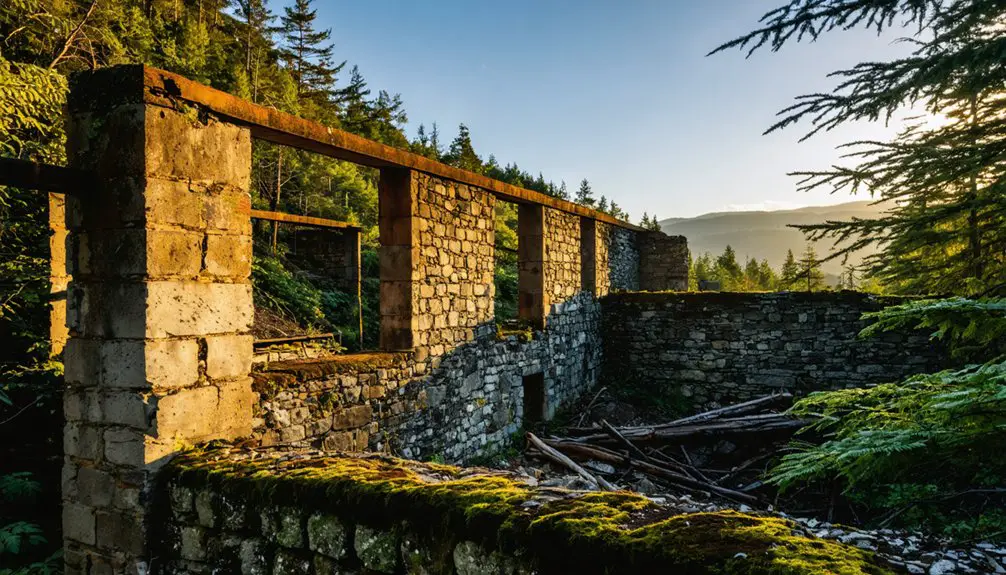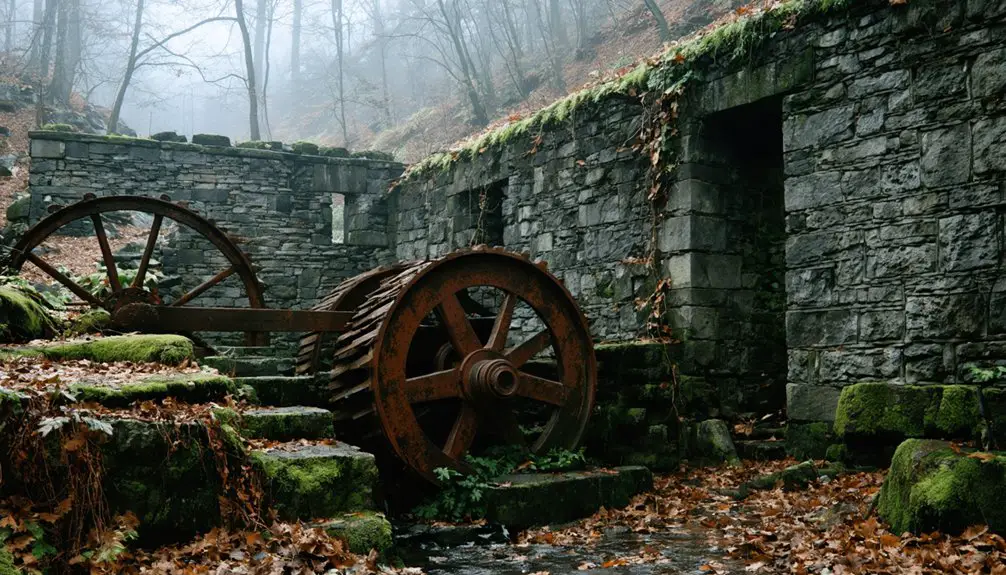You’ll find White Rock’s ghost town remnants along Armstrong County’s Ghost Town Trail, where a once-bustling coal mining community thrived from the late 1800s until its decline in the 1950s. The site features deteriorating foundations, scattered mining artifacts, and a striking blue-green flooded quarry that reaches depths of 70 feet. The town’s abandonment in 1961 occurred when quarry pumps stopped, leaving behind compelling traces of Pennsylvania’s rich coal mining heritage waiting to be discovered.
Key Takeaways
- White Rock was a thriving Pennsylvania mining town that became abandoned in the early 1960s after its quarry flooded to depths of 70 feet.
- The town’s economy centered around bituminous coal mining and coking operations, with 356 ovens operating at the Walston site by 1885.
- The community’s decline began in the 1940s when dolomite mining operations failed, leading to only 40 miners remaining by 1954.
- Visitors can explore White Rock’s remains along the Ghost Town Trail, which features ruins, mining artifacts, and Russian Orthodox cemeteries.
- The flooded quarry’s blue-green waters and deteriorating building foundations serve as visible reminders of the town’s mining heritage.
The Rise of a Coal Mining Community
As Pennsylvania’s bituminous coal industry expanded in the late 18th century, White Rock emerged as a significant mining settlement in the state’s western coal region.
You’ll find that the community’s early growth centered around room-and-pillar mining operations, where miners extracted the valuable “soft coal” that would fuel Pittsburgh’s industrial revolution.
The community dynamics evolved rapidly as mining companies invested in infrastructure and technology. By 1830, the demand for coal was so high that four hundred tons were consumed daily in Pittsburgh alone.
You’ll see how the shift from basic transportation methods like canoes and mules to extensive rail networks transformed White Rock’s economic potential.
Despite labor challenges and hazardous working conditions, miners produced 2-3.5 tons of coal daily. Records show miners earned $3.80 per day for their dangerous work.
The town’s development paralleled the region’s shift from eastern Pennsylvania’s anthracite dominance to western bituminous coal production, creating a thriving community built entirely around mining operations.
Life in White Rock’s Golden Era
Three distinct pillars shaped daily life in White Rock during its peak years: the coal company’s omnipresent influence, the tight-knit community bonds, and the shared mining heritage that defined every aspect of existence.
You’d find yourself living in company-owned housing, where your neighbors became extended family through shared experiences and challenges. Community gatherings centered around churches and local stores, while miner traditions marked the rhythm of daily life. Working at the Rand Powder Company became a cornerstone of employment for many residents. The town faced a similar fate to Yellow Dog Village, with decaying homes standing as silent reminders of a once-thriving mining community.
Your children would attend modest local schools, and you’d rely on basic amenities controlled by the coal company. Despite modest wages and ever-present safety risks, you’d experience strong solidarity among residents who supported each other during strikes, accidents, and hardships.
Local folklore and stories of mining exploits bound the community together, creating a resilient cultural identity that endured.
Mining Operations and Economic Backbone
While Western Pennsylvania’s coalfields stretched across vast territories, White Rock’s mining operations centered on bituminous coal extraction using the traditional room-and-pillar method.
You’d find skilled teams of miners working the Pittsburgh coal seam, leaving strategic pillars to support the roof while extracting valuable deposits.
The town’s economic backbone relied heavily on these mining techniques, with coal production driving employment and supporting related industries like transportation and steel manufacturing.
You could see the impact of economic fluctuations firsthand, as the community’s fortunes rose and fell with coal market demands.
River and rail networks proved essential, transforming White Rock from an isolated mining camp into a significant link in the industrial supply chain, though this dependence on coal eventually contributed to the town’s vulnerability when the industry declined.
The War of 1812 had dramatically changed the region’s coal industry when British naval blockades forced a widespread shift from imported coal to domestic sources.
The region’s mining industry saw similar challenges to those faced by Lehigh Coal Mine Company in its early days, struggling with efficient transportation of coal to market.
The Coking Industry’s Local Impact
The coking industry transformed White Rock from a simple mining town into an essential industrial hub by the late 19th century.
You’ll find that coke production became the economic backbone of the region, with the Walston site alone operating 356 ovens by 1885. The high-quality coke produced from local mines supplied foundries across the Great Lakes region and as far as Chicago. By 1905, Pennsylvania was producing 18 million tons of coke annually.
Local employment soared as hundreds of men found work in the coking operations, which required specialized skills beyond coal mining. These workers earned approximately two dollars per oven for their labor.
Skilled coking workers drove the region’s economic boom, bringing new technical expertise and hundreds of jobs to the growing community.
You can trace the community’s rapid growth through developments like Eleanora, where 80 houses sprung up in just two years to accommodate workers.
The industry’s success rested on the region’s pure water sources and premium lower Freeport coal beds, which yielded coke that rivaled the renowned Connellsville variety.
Architectural Legacy and Remaining Structures
Despite widespread demolition throughout White Rock’s history, several significant structures remain as evidence to the town’s vibrant past. Similar to poisonous gas releases in other abandoned mining towns, environmental hazards have restricted access to certain areas of White Rock. The nearby mountains contain remnants of early coal mines discovered in 1791.
You’ll find the Stone Church standing prominently as a community focal point, while military bunkers from the WWII era dot the landscape, offering unique architectural preservation opportunities. The town’s religious heritage lives on through multiple historic churches and their adjoining cemeteries, including the Presbyterian Church Cemetery with its colonial-era headstones.
- Original street traces and house foundations reveal White Rock’s former layout
- Six preserved cemeteries serve as essential historical records
- Round bunkers showcase the town’s connection to nuclear storage during WWII
- Historic churches, including the Stone Church, remain accessible for special events
These historical structures paint a vivid picture of White Rock’s architectural evolution from colonial settlement to military installation.
The Decline and Abandonment
Once dolomite mining operations began faltering in the 1940s, White Rock’s fate as a ghost town was sealed. The town’s economic vulnerability became apparent as workforce reductions left only 40 miners employed by 1954.
When the quarry finally ceased operations in 1957, the remaining residents faced an impossible choice: relocate or face unemployment.
The population decline accelerated through the 1950s, with just a handful of families remaining by mid-decade.
The final blow came in 1961 when the quarry pumps stopped, flooding the mine with water that reached depths of 70 feet.
Without jobs or services to sustain the community, White Rock’s transformation from thriving mining town to abandonment was complete by the early 1960s, leaving behind only the haunting blue-green waters of the flooded quarry.
Historical Significance in Pennsylvania’s Coal Region

While White Rock’s dolomite quarry defined its brief existence, the town’s story fits within Pennsylvania’s broader legacy as America’s coal mining heartland.
From dolomite to coal, White Rock echoes Pennsylvania’s rich mining heritage that shaped America’s industrial might.
You’ll find the state’s earliest coal discovery dates to the late 1700s, with mining history shaped by both anthracite in the east and bituminous coal in the west. These resources transformed Pennsylvania into an industrial powerhouse, fundamentally altering its landscape and communities.
- The Lehigh Coal and Navigation Company revolutionized coal transport methods, setting precedents that influenced mining towns like White Rock.
- Over 70,000 miners lost their lives during the industrial coal boom (1880-1923).
- United Mine Workers formed in 1890, fighting for better working conditions.
- Pennsylvania’s coal-driven economy created thousands of jobs while spurring the growth of steel production and railroads.
Exploring White Rock’s Ghost Town Remnants
Today’s visitors to White Rock can explore tangible connections to Pennsylvania’s rich coal mining heritage through the town’s remaining physical traces.
You’ll find the ghost town’s remnant exploration opportunities along the 36-mile Ghost Town Trail, which connects several abandoned coal communities in Armstrong County.
As you venture through the site, you’ll discover deteriorating foundations and scattered ruins beneath dense forest cover.
While most structures have succumbed to time, ghostly artifacts occasionally surface, including mining tools and company store remnants.
The area’s Russian Orthodox cemeteries offer glimpses into the diverse ethnic heritage of these mining communities.
Black Lick Creek flows nearby, still bearing the acidic scars of coal mining, while interpretive signage along the trail helps you piece together White Rock’s fascinating past.
Frequently Asked Questions
Are There Any Documented Paranormal Activities or Ghost Sightings in White Rock?
While you’ll find plenty of local legends, there’s no verified spectral evidence from White Rock. Though ghostly encounters are mentioned in folklore, no formal paranormal investigations have documented conclusive activity there.
What Happened to the Families Who Lived There After White Rock’s Abandonment?
Like scattered seeds in the wind, families’ migration led to nearby towns like Fairchance and Uniontown. You’ll find they sought jobs elsewhere, though community memories remained through stories and occasional visits.
Does Anyone Still Legally Own Property Within White Rock’s Boundaries Today?
You won’t find current private property ownership within these boundaries today – legal status likely reverted to county or state control through abandonment, tax liens, or eminent domain actions, similar to other ghost towns.
Were There Any Major Mining Accidents or Disasters in White Rock?
While mining safety was precarious everywhere, historical records don’t document any major disasters specifically in White Rock, though nearby Pennsylvania mines experienced numerous fatal accidents during the late 1800s and early 1900s.
Can Visitors Legally Access and Explore White Rock’s Remaining Structures?
You can legally explore public areas but must follow safety precautions and exploration guidelines. Avoid private properties, watch for unstable ground, and stay away from toxic gas zones and mine-fire hazards.
References
- https://uncoveringpa.com/ghost-towns-in-pa
- https://www.youtube.com/watch?v=Qj5LjacccJ0
- https://en.wikipedia.org/wiki/List_of_ghost_towns_in_Pennsylvania
- https://www.susquehannaheritage.org/riverroots-forgotten-town/
- https://en.wikipedia.org/wiki/Centralia
- https://www.pa.gov/agencies/dep/programs-and-services/mining/bureau-of-mining-programs/pa-mining-history.html
- https://www.historylink.org/File/8262
- https://en.wikipedia.org/wiki/History_of_anthracite_coal_mining_in_Pennsylvania
- https://delawareandlehigh.org/about/history/coal-commerce-and-industry/
- https://philadelphiaencyclopedia.org/essays/coal/



